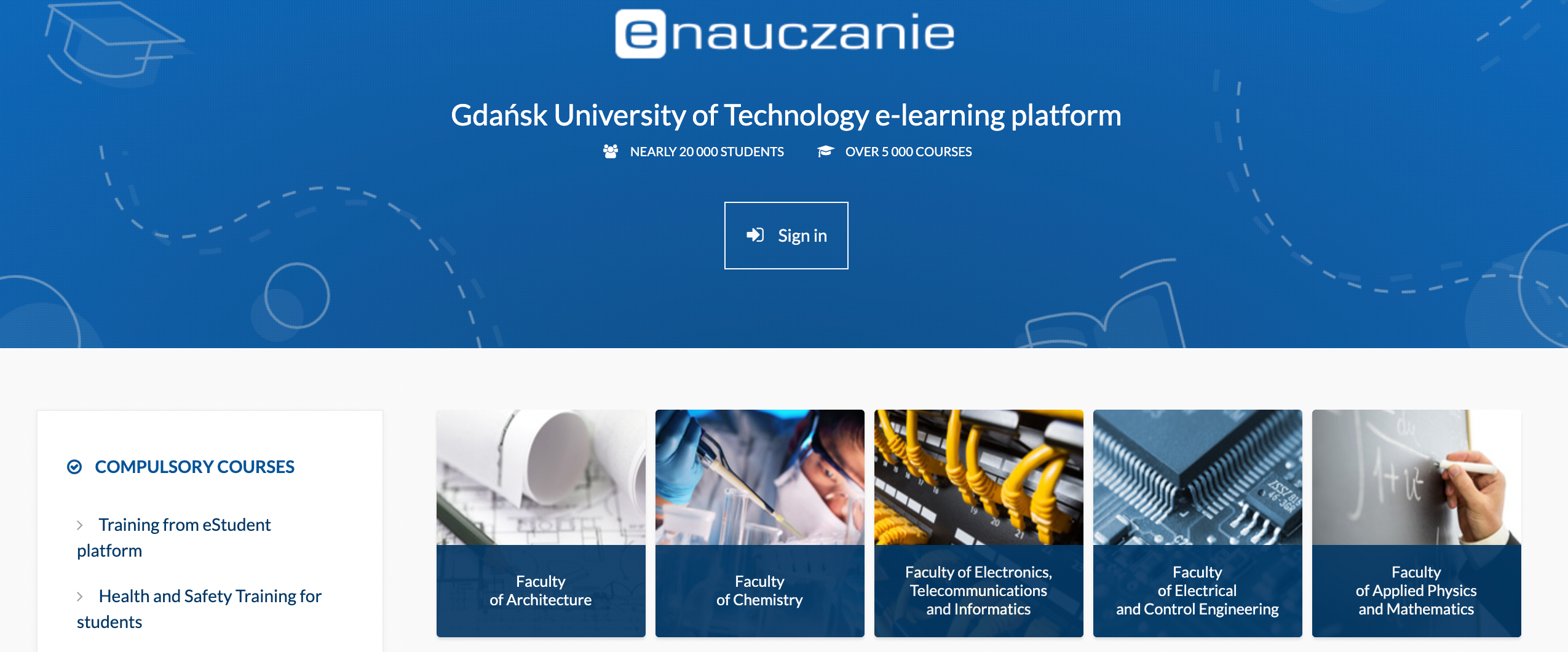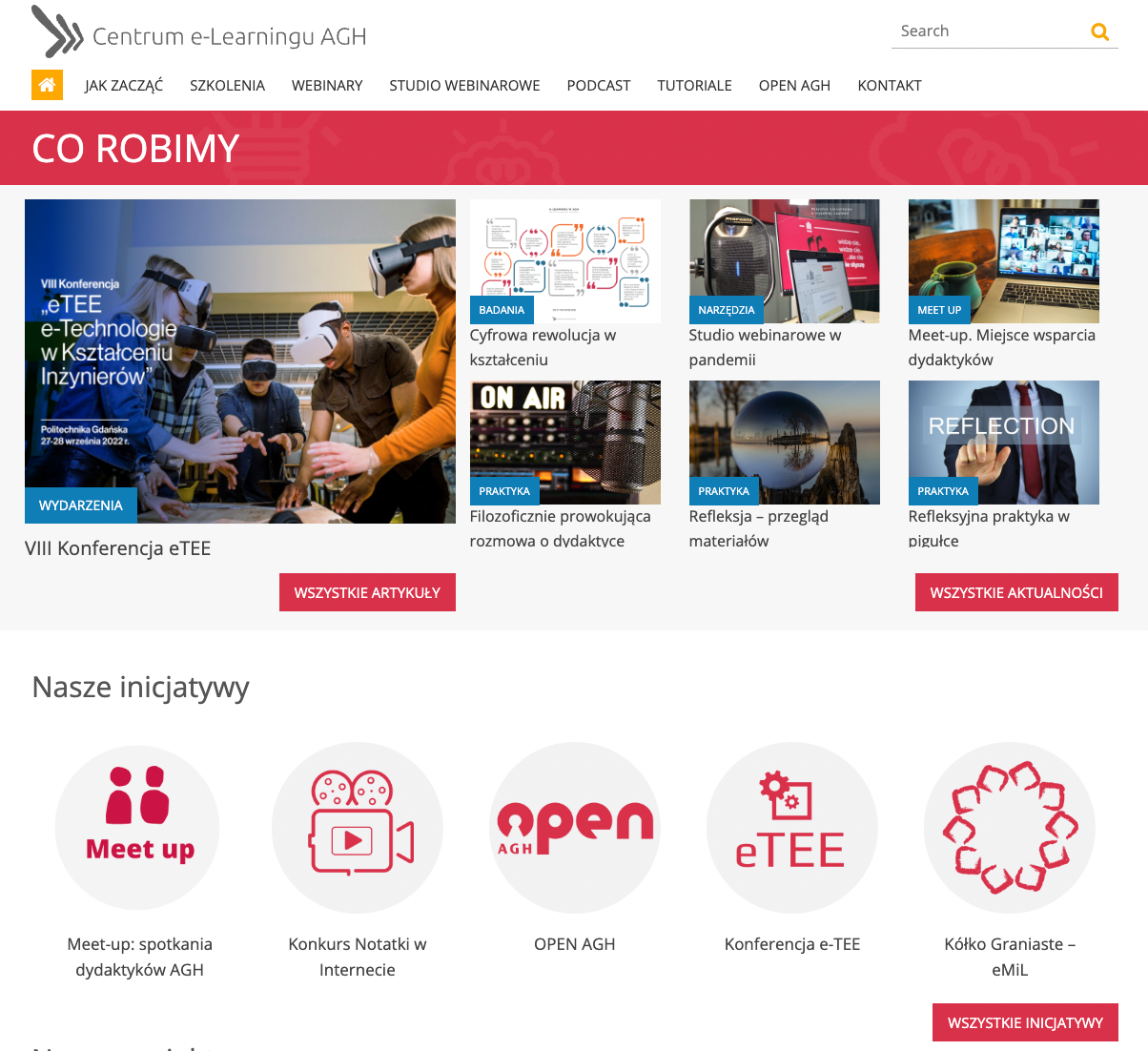The development of e-learning would not be possible without advanced tools. Many of them cover learning management and focus on providing the right environment for distance learning. LMS platforms play a key role in the whole process. In this article, you will learn what they are, how to use them, and how to integrate them with tools for webinars and online meetings.
e-Learning is not just about virtual lessons. Every teacher, educator, or owner of a training company knows very well how many activities need to be performed to make distance learning possible and effective. The range of responsibilities is very wide and includes, on the one hand, formal and administrative issues, and, on the other hand, arranging the work and preparing tools that would help to share the knowledge. A learning management system (LMS), therefore, becomes the backbone of the whole process. This solution is not dedicated only to the largest institutions, as it might seem. Its features can also be successfully used by small training companies, as well as public or language schools.
Table of Contents
What is an LMS?
LMS (learning management system) is software that supports the process of remote learning. It takes various forms. Most often, an LMS platform provides instructors and users with:
- Easy access to online courses,
- Registration for courses,
- Distribution of learning materials,
- Tracking students’ progress,
- Direct delivery of various types of classes,
- Monitoring results,
- Efficient workflow.
Of course, LMS systems are a very broad category of tools. Most often, an LMS platform is a comprehensive software solution that aggregates the various IT solutions necessary for engaging knowledge sharing and learning.
However, other types of IT solutions supporting the remote learning process are also often defined this way. These include, for example, LCMS (Learning Content Management System) systems, which are used to plan, deliver and manage learning events within an organization. While the LMS platform addresses the needs of both instructors and learners, LCMS systems focus primarily on the first group.
How does the LMS platform work?
Of course, from the perspective of both the instructor and the people attending the class, the performance of the LMS platform will prove to be the most important. The right configuration affects the e-Learning experience positively and significantly facilitates the transfer and absorption of knowledge.
It is worth taking a closer look at the capabilities of a learning management system based on the experience of e-learning leaders.
Gdansk University of Technology’s LMS platform
The eLearning platform of the Gdansk University of Technology – one of the best technical universities in Poland – has to meet the demands of 1,400 university teachers and nearly 20,000 students.
The solution supports e-Learning comprehensively thanks to the possibilities offered by the LMS Moodle. An important component of the platform is also ClickMeeting, which offers convenient creation of classes in the form of interactive webinars and online meetings. Integration with the e-Learning platform means that both lecturers and students can join events directly from the LMS platform. There is also no need to leave it to create an event.

Gdansk University of Technology provides this way, among other things:
- lectures,
- online training,
- consultations,
- seminars,
- scientific conferences and team meetings.
In addition, the LMS platform provides access to an extensive statistics panel. Users can use it not only on computers but also on mobile devices. One of the most important features of the system is its simplicity:
When booking a webinar, the academic teacher chooses, among other things, the profile of the meeting – whether it is to be a large event, e.g., a lecture, or a meeting for a smaller number of people, that works well for seminars. Next, they choose the date and time of the event. They can also introduce access regulations to the event. For example, it can exclude students who have not given the required consent.
Anita Dąbrowicz-Tlałka, PhD, Gdańsk Tech Professor
Online learning at the AGH University of Science and Technology in Krakow
AGH University of Science and Technology in Cracow is one of the leaders in e-Learning. The best technical university in the country has established a special e-Learning Center, which is responsible, among other things, for the staff training programs, creating training courses to expand their competence in distance learning, and preparing various events, including large international conferences.
Experts provide users with extensive tools. The basis of remote teaching at AGH is the UPeL platform based on LMS software Moodle. ClickMeeting is one of the solutions that allow lecturers to meet directly with students.

Teachers use the Virtual Class mode to create classes. They can choose the class size depending on specific needs – virtual classes of up to 50 or 200 people are available. They also set the date of the meeting and, if necessary, the access password. This way, employees can comfortably and safely transfer their classes to the virtual space.
Anna Wrona – methodologist at the AGH UST Centre of e-Learning
An important part of maintaining the quality of e-learning at the university is staff training. Before gaining access to the LMS platform and transferring classes online, lecturers must attend the training provided by the e-Learning Center employees. This way, they quickly master the principles of the system and develop the skills necessary for effective online learning. They also benefit from courses and training to improve their skills in remote teaching methodologies.
LMS: benefits for educators
Why are more and more schools, universities, or companies specializing in organizing training choosing to use LMS systems? The answer is simple – they significantly improve the process of both teaching and organizing the work of the entire entity. For employees, this means definitely easier performance. From the perspective of participants, on the other hand, acquiring knowledge is more pleasant and intuitive.
Here are the basic functions of the LMS platform used by organizers of educational activities:
- Create courses: these are linked to specific subjects within the LMS platform. With just a few clicks, you can create an eCourse, book events, enrich them with a wide selection of training materials and monitor registration.
- Event preparation: with eLearning, online classes obviously play a key role. The LMS provides intuitive creation of events tailored to a specific purpose – you can create both practical exercises in smaller groups and large lectures or conferences.
- Sharing additional materials: the effective performance of e-learning methodologies requires expanding the course content displayed during classes. Learning management systems make it easy to share additional materials, and learners don’t have to leave the platform to access them, thanks to cloud-based technology.
- Automatic recording and distribution of recordings: courses, trainings, and lectures will be even more attractive if you provide learners with their recordings directly from the system. A properly configured LMS allows you to automatically record events and then publish them, for example, in a dedicated module of the platform.
- Granting access to attendees: security issues play a key role in e-learning. The learning management system makes it possible to register students for specific courses while ensuring a high level of security. So you don’t have to worry about unwanted people gaining access to content or downloading materials reserved for authorized individuals.
- Managing employee permissions: the problem, especially for large educational organizations, is to take care of new employees comfort and manage their permissions. A good LMS platform will allow them to assign diverse roles, ensuring easier operation and high stability.
- Delivering lessons: e-learning methods are, of course, based on direct contact between instructors and participants during lessons or training sessions. The LMS provides a convenient transition to a specific virtual classroom. Advanced integration will ensure that users do not have to leave the platform. At the same time, you will keep access to all interactive features of webinars and online meeting tools.
- Verifying knowledge: the range of learning activities necessary for effective remote learning is wide and conducting interactive lectures, exercises, or training sessions is not enough. It is also necessary to verify students’ knowledge by, for example, organizing tests. For this purpose, you can use the possibilities offered by the classroom platform or reach for solutions available within the LMS modules.
- Access to statistics: Learning Management Systems are primarily learning tools that let you to improve the strategy you apply and run training or other types of educational activities even more effectively. You gain access to extensive statistics and feedback that will allow you to monitor the learning process for a specific group of students and conscientiously analyze the effectiveness of your actions.
LMS from a participant’s perspective
Of course, an LMS is supposed to support first and foremost the users who are gaining knowledge, which means participants in your courses, training sessions, lessons, or lectures. How do well-configured platforms help them achieve their goals?
- Easy login to the virtual classroom: when it comes to remote learning, problems with gaining access to content are a major concern. A well-thought-out platform using an LMS significantly simplifies the procedure and reduces the necessary steps to a minimum. Often, it only takes a few clicks to join a class.
- Access from multiple devices: it is increasingly apparent that e-learning is giving way to a new trend – m-learning, i.e., remote education that relies primarily on mobile solutions. It allows students to access content via a smartphone or tablet. Also, instructors can control the knowledge transfer process without device limitations.
- Interactive LMS features: training sessions, practical exercises, but also lectures held remotely can also be engaging and use differentiated teaching methods. For this to happen, the virtual classroom must offer interactive features. A good platform for webinars and online meetings integrated with best LMS is the way to achieve great results.
- Contact with instructors: The LMS allows you to keep in touch between the presenters and the audience even outside the virtual classroom.
- Monitoring progress: the LMS makes it possible to continuously analyze your results and manage your time more efficiently.
- Everything within a single platform: the biggest advantage of the LMS is convenience. This is a benefit both from the perspective of the employees of the university, school, or training center, as well as the learners. Basically, everything you need to organize classes, teach and acquire knowledge can be found within a single service.
Who needs learning management support?
Contrary to appearances, LMS are not only the solutions addressed to the most advanced entities. Where can they be used?
- Public and private schools,
- Universities,
- Language schools,
- Platforms offering online courses,
- Companies that specialize in delivering training,
- Companies providing training for their own employees,
- Consulting and coaching companies.
The main advantage of the LMS is its high flexibility and ability to customize the learning management system to meet individual expectations. Thus, on the one hand, it can be a comprehensive environment that allows moving all educational activity to the Internet. On the other hand, it can be limited, for example, to modules that allow training planning and provide users with access to course recordings and additional content. Interestingly, an LMS doesn’t have to involve major expenses, so it’s worth thinking about its implementation even if training activities are just an additional area of the company’s operations.
Moodle – a free LMS environment
One of the most popular LMS is Moodle. It is free, open-source software made available under the GNU GPL license. So anyone can simply download and install the platform and then customize it to suit their needs. Extensive technical skills won’t always be needed for this. A big help is various types of plug-ins that allow, for example, integration of the LMS with a tool for webinars and online meetings. Below you can see what this looks like for ClickMeeting:
Even more possibilities are provided by taking advantage of the platform’s open API. This allows you to fully customize the LMS and create a unique system that is friendly to all users: both employees and students.
From a developer’s perspective, the most useful feature of ClickMeeting is the Open API, which is an open application programming interface. This allows us at the IT Services Center to create tools so that university teachers can manage a large number of online meetings, as well as access extensive statistics and analysis.
Mikolaj Grochowski, M.Sc.
Virtual classroom
Of course, one of the most important spaces within LMS platforms is the virtual classroom. This is where training, practical and project activities, lessons, or lectures take place. So if you’re looking to create a consistent system that will be appreciated by both employees and students, you need to choose the right platform for webinars and online meetings. Here’s a list of the most important features to look out for.
- Ability to organize different types of events: on the one hand, you create practical training sessions for small groups, and on the other hand, lectures for hundreds of people or large promotional events? With the right platform, you can combine different activities without having to reach for additional tools.
- Fostering collaboration: effective e-learning requires activating and engaging users. So be sure the platform allows you to use a virtual whiteboard and chat, for example. Breakout rooms are also one of the interesting features: thanks to them, you can divide the event’s users into smaller groups and let them focus, for example, on project work.
- Customizing event room: a modern LMS allows you to customize not only the features but also the appearance of the platform to match the color scheme and visual style of your company or school. It will be no different with the virtual room where educational activities take place. By doing so, you will create a coherent platform that will improve the prestige of training and the comfort of users.
- Intuitive use: it is also very important to join events easily. With the right solutions, trainees will be able to log in with a few clicks, and the virtual classroom will be accessible via a browser.
- Integration with LMS: if you want to create a comprehensive platform for training and virtual lessons, you need to pay attention to whether the software used to organize events enables integration with LMS. This will give you the ability to create events and join them without leaving the system.
- Mobile device support: in order for your LMS to take advantage of m-learning, the right solutions must also be offered by the platform for online events.
In the case of ClickMeeting, you can test the platform’s features during a free 30-day trial period. So you have plenty of time to test the most important features, including automation!








